|
|
Noble Metal Phosphide Electrocatalysts and Their Synchrotron-based X-ray Absorption Spectroscopy
ZHOU Yuzhu, ZHANG Youkui, SONG Li
2021 Vol. 36 (3): 225–244
 Abstract
Abstract(
961 )
 HTML
HTML(
53)
 PDF
PDF(27735KB)(
1632
)
Electrocatalytic technology is one of the most attractive technologies for renewable energy storage and conversion, and nano-scale noble metals exhibit excellent electrocatalytic activity. However, because of the scarcity of precious metal resources and high development costs, reducing the dosage of precious metals while improving activity and durability of catalysts is always the research focus in the field of catalysis applications. Among various candidates, noble metal phosphide-based new electrocatalysts have received widespread attention due to their multifunctional active sites, adjustable structure and composition, and unique physical and chemical properties. Compared with transition metal phosphide, noble metal phosphides have higher intrinsic activity, and exhibit better stability under acid condition. In this review, the research progress of noble metal phosphides was mainly summarized including design synthesis, structural engineer, X-ray absorption spectroscopic characterization, and electrocatalytic applications. Eventually, the current challenges and opportunities for the development of noble metal phosphide-based electrocatalysts were discussed, along with the future prospection of in situ synchrotron radiation X-ray characterizations that might be applied in this field.

|
|
|
Micro-nano Ceramic Fibers for High Temperature Thermal Insulation
ZHANG Xiaoshan, WANG Bing, WU Nan, HAN Cheng, WU Chunzhi, WANG Yingde
2021 Vol. 36 (3): 245–256
 Abstract
Abstract(
2017 )
 HTML
HTML(
95)
 PDF
PDF(15953KB)(
3053
)
Ceramic fiber has the advantages of low density, high strength, high temperature resistance and good mechanical vibration resistance. It is the critical high temperature thermal insulation materials especially in thermal protection fields such as aerospace vehicles, nuclear power plants and chemo-metallurgical industry, etc. The traditional ceramic fiber with large diameter (> 5 μm), high brittleness and high thermal conductivity has been greatly restricted in high temperature thermal insulation fields. In recent years, more and more attention has been paid to the preparation of micro-nano ceramic fibers by decreasing the diameter of fiber, which is not only beneficial to improve the mechanical properties of the fibers, but also to enhance their high temperature thermal insulation properties. Further, by finely regulating the composition and structure of the micro-nano ceramic fibers that intrinsically affecting the heat transfer (heat conduction of gas, heat conduction of solid and radiative heat transfer) mechanism in micro-nano ceramic fibers, the high temperature thermal insulation performance can be effectively improved, which is the current focus of the micro-nano ceramic fibers in high temperature thermal insulation fields. The thermal insulation mechanism of the micro-nano ceramic fibers was firstly introduced. Then, based on the research at home and abroad, this review divides the current micro-nano ceramic fibers into three categories according to the difference of their composition and structure, namely fibers aerogels, hollow/porous fibers and composite fibers. The latest research progress on composition and structure optimization of micro-nano ceramic fibers for high temperature thermal insulation is reviewed, and the future development tendency is prospected.
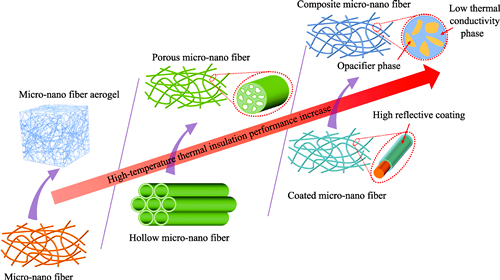
|
|
|
Nanozyme: a New Strategy Combating Bacterial
FU Jiajun, SHEN Tao, WU Jia, WANG Chen
2021 Vol. 36 (3): 257–268
 Abstract
Abstract(
1266 )
 HTML
HTML(
68)
 PDF
PDF(11255KB)(
1848
)
Bacteria-related diseases, environmental pollution and other issues have attracted enough attention. Meanwhile, with the use of antibiotics, bacteria evolved strong drug resistance forcing people to develop new antibacterial agents urgently. Natural enzymes such as lysozyme and myeloperoxidase have significant antibacterial ability. However, natural enzymes own limitations such as short shelf life and high production costs. Besides, they are difficult in applying to large-scale production. Therefore, people are seeking alternatives to natural enzymes. Nanozymes are a new generation of artificial enzymes which have unique physical and chemical properties of nanomaterials and enzyme-like catalytic activity. Because of structural stability and low production cost, they are widely explored. This article reviews the antimicrobial mechanism and the recent progress of nanozymes in antibacterial research, and, finally, gives some prospects for future research.
|
|
|
First Principles Study of Electronic Structure and Optical Properties of ZnNb2O6 with Vacancy Defects
YAN Yuxing, WANG Fan, ZHANG Juexuan, LI Fushao
2021 Vol. 36 (3): 269–276
 Abstract
Abstract(
723 )
 HTML
HTML(
25)
 PDF
PDF(4981KB)(
1134
)
Niobate materials, such as LiNbO3, KNbO3, LnNbO4 (Ln=Pr, La, Ga, Y), etc. have attracted wide attention due to their excellent photosensitivity. However, the transition metal niobate is rarely studied, and the relationship between its photoelectric properties and vacancy defects has not been thoroughly explored. Here, the effect of vacancy defect on electro-optical characteristics of ZnNb2O6 system was studied based on first-principles of density function theory. Its geometric structure, electronic structure, and optical spectrum clearly revealed the effect of electro- negativity and geometric position of atoms on the structure and electronic energy level. At the center of the octahedron, atoms, such as Zn and Nb, contributed similarly to the energy band, and had relatively fixed positions on the valance band when they formed vacancy defects. However, Nb atoms with larger electro-negativity generated larger lattice distortions, more obvious negative shifts of the conduction band, and red shifts of the absorption edge upon the formation of vacancy defects, which are conducive to improving electro-optical characteristics. Atom O at the vertices of the octahedron generated smaller lattice distortions when vacancy defects formed. However, negative shifts occurred at the conduction and valance bands, and impurity energy levels emerged on the Fermi surface, which induced the formation of “capture traps” on the charge carriers. This in turn exerted a larger influence on the redistribution of charge, resulting in a blue shift of the system in whole, and an all-round enhancement of optical spectrum intensity.

|
|
|
Photostriction of NBT-BNT Ceramics
DONG Zhengming, LI Xiu, CHEN Chen, CAO Minghe, YI Zhiguo
2021 Vol. 36 (3): 277–282
 Abstract
Abstract(
583 )
 HTML
HTML(
14)
 PDF
PDF(927KB)(
807
)
Photostrictive materials exhibit great potential in the light-driven microactuators/sensors, light-controlled microrobots, and other optomechanical applications. In this study, we present the photostrictive performance of Ni-modified Na0.5Bi0.5TiO3-BaTiO3 (NBT-BT) ceramics prepared by using spark plasma sintering. Under visible light illumination (405, 520 and 655 nm, respectively), the Na0.5Bi0.5TiO3-Ba(Ti0.5Ni0.5)O3 (NBT-BNT) ceramics exhibits large photostriction of the order of 10 -3 and photostriction coefficient around 10 -11 m 3/W. The XRD peaks of the sample under external illumination show low angle shift, indicating the light-induced lattice distortion, which contributes to the large photostrictive response of NBT-BNT ceramics.
|
|
|
Preparation of TiO2/Ti3C2Tx Composite for Hybrid Capacitive Deionization
XI Wen, LI Haibo
2021 Vol. 36 (3): 283–291
 Abstract
Abstract(
567 )
 HTML
HTML(
24)
 PDF
PDF(2499KB)(
1113
)
The shortage of fresh water resources resultes from the rapid growth of population and industrial development. Desalination of seawater and brackish water is an effective way to alleviate the freshwater crisis. In this work, the TiO2/Ti3C2Tx composites were prepared by directly calcinating Ti3C2Tx for hybrid capacitive deionization (HCDI). The results show that the calcination temperature has a significant impact on morphology, structure, electrochemical and desalination behavior of the TiO2/Ti3C2Tx composites. To constitute the full HCDI device, the optimized TiO2/Ti3C2Tx and acid treated activated carbon (AC) was employed as cathode and anode, respectively. In the constant voltage mode, the salt removal capacity of TiO2/Ti3C2Tx‖AC reached 23.8 mg·g -1 under the cell voltage of 1.2 V in NaCl solution with an initial conductivity of 3000 μS·cm -1. After 20 cycles, the capacity retention rate remains at 78%. Besides, through exploring the morphology and crystal texture evolution of TiO2/Ti3C2Tx electrodes before and after desalination, it is found that the desalination of TiO2/Ti3C2Tx electrodes may be achieved due to the intercalation of sodium ions into the Ti3C2Tx interlayer.

|
|
|
Potential Induced Reversible Removal/Recovery of Phosphate Anions with High Selectivity Using an Electroactive NiCo-layered Double Oxide Film
YANG Yanyan, LI Yongguo, ZHU Xiaowen, DU Xiao, MA Xuli, HAO Xiaogang
2021 Vol. 36 (3): 292–298
 Abstract
Abstract(
541 )
 HTML
HTML(
10)
 PDF
PDF(1267KB)(
975
)
Phosphorus is an essential nutrient for organisms growth and a major cause of eutrophication in water bodies. Thus, it is crucial for both of the removal and recovery of phosphate from wastewater. In this work, the NiCo-layered double oxide (NiCo-LDO) was successfully fabricated on carbon cloth conductive substrate via the in-situ calcination of the NiCo-layered double hydroxide (NiCo-LDH) and served as the electrochemically switched ion exchange (ESIX) film electrode for the removal and recovery of PO4 3-. The performance of NiCo-LDO for PO4 3- removal by ESIX and ion exchange (IX) was compared, while the selectivity and stability of NiCo-LDO for PO4 3- removal were also investigated. The results revealed that, in (10.00±0.05) mg/L PO4 3- solution, the ion exchange quantity of the NiCo-LDO for PO4 3- removal by ESIX process was about twice over that by IX. Moreover, compared with Cl -, NO3 -, SO4 2- and I -, the NiCo-LDO exhibited much higher selectivity towards PO4 3-. In addition, the ion exchange quantity still retained 92% of its initial value after 5 uptake and release cycles. Coupled with XPS analysis, it was found that ESIX process of NiCo-LDO film electrode for PO4 3- removal and recovery mainly consisted of 3 steps, which were an irreversible “memory effect” structure recovery process, the redox reaction of metal ion in lamellar and the ligand exchange between PO4 3- and O-H groups.
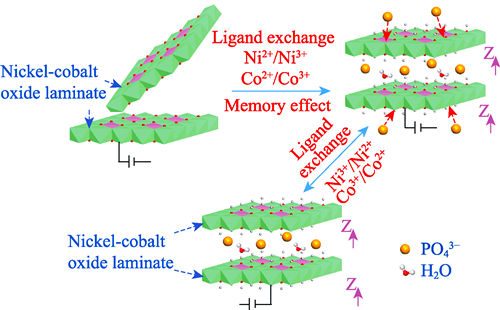
|
|
|
Synthesis and Property of Platinum-cobalt Alloy Nano Catalyst
ZHU Yong, GU Jun, YU Tao, HE Haitong, YAO Rui
2021 Vol. 36 (3): 299–305
 Abstract
Abstract(
709 )
 HTML
HTML(
37)
 PDF
PDF(5787KB)(
1046
)
In order to achieve the commercialization of proton exchange membrane fuel cells (PEMFCs), it is necessary to synthesize electrocatalyst with higher electrochemical activity. In this study, PtCo nano-alloy electrocatalyst was prepared by liquid phase synthesis method with sodium borohydride as reducing agent, triethylamine as complexing agent, and by sequential heat-treatment. The physical properties of the catalyst were characterized by different analytical methods. We studied the effects of heat-treatment temperature, different amounts of sodium borohydride and triethylamine on electrochemical performance. The results show that heat-treatment can greatly improve the mass activity of the catalyst, and 500 ℃ is the optimal temperature for preparing the catalyst with the highest catalytic performance towards oxygen reduction reaction(ORR). Compared with commercial TKK-PtCo alloy catalyst under the same test system, the as-prepared catalysts exhibits advantages of more uniform particle size distribution, smaller particle size and higher electrochemical performance. In particular, the mass activity (MA) of the prepared catalyst is 133 mA/mgPt, which is 3 times of TKK-PtCo alloy catalyst.
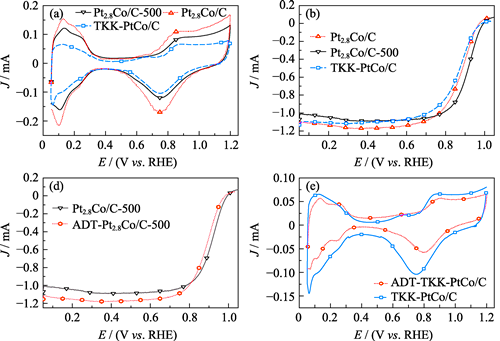
|
|
|
Microwave Absorbing Properties of Novel SiC/Cf Composites Containing SiC Array Modified Coating
WU Zhihong, DENG Yue, MENG Zhenzhen, ZHANG Guoli, ZHANG Luping, WANG Yubin
2021 Vol. 36 (3): 306–312
 Abstract
Abstract(
647 )
 HTML
HTML(
23)
 PDF
PDF(2822KB)(
1164
)
A novel SiC/Cf composite with SiC array modified coating was prepared by electroless plating combined with high temperature sintering using glucose, Si powder and carbon fiber as raw materials. The phase composition, microstructure and absorbing properties of SiC/Cf composites were characterized by different methods. The results show that the surface of the carbon fiber is coated with a large amount of SiC arrays, which grows outward on the surface of the carbon fiber. The SiC arrays are uniformly distributed and approximately 1.4 μm in height. When the thickness of SiC/Cf composite is about 1-2 mm, with the thickness increasing, the minimum reflection loss (RLmin) moves from high frequency to low frequency. When the absorber thickness is 1.8 mm, the RLmin reaches -40.653 dB at 8.31 GHz and the effective absorption bandwidth (RL < -10 dB) is 1.11 GHz. When the thickness is 1.5 mm, the minimum effective absorption bandwidth can reach 2.42 GHz. Additionally, the RLmin is less than -20 dB when the absorber thickness ranges from 1.3 to 1.8 mm. This new SiC/Cf composite modified by SiC array is expected to be a lightweight and efficient electromagnetic absorbing material.
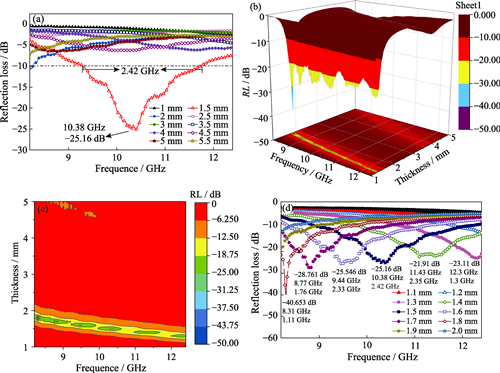
|
|
|
Mechanical Property of SnSe Single Crystal Prepared via Vertical Bridgman Method
JIN Min, BAI Xudong, ZHAO Su, ZHANG Rulin, CHEN Yuqi, ZHOU Lina
2021 Vol. 36 (3): 313–318
 Abstract
Abstract(
500 )
 HTML
HTML(
15)
 PDF
PDF(1244KB)(
898
)
Ⅳ-Ⅵ SnSe single crystal is an attractive thermoelectric (TE) material due to its outstanding TE behavior and environment friendly charactistic. In this work, an effective way for SnSe single crystal growth was explored, and the mechanical property of the as-prepared product was investigated. Undoped SnSe single crystal with accurate stoichiometric ratio was successfully grown via a vertical Bridgman method. The as-grown SnSe single crystal has standard orthorhombic Pnma space group at room temperature. It is easy to cleave along (100) plane because of its weak link between adjacent Sn-Se layers. Microindentation test reveals that SnSe single crystal is a very soft material as its average Vickers microhardness HV is only 53 MPa under 0.01-0.05 kg applied loads. However, it displays excellent fracture toughness due to strong heteropolar bonds between Sn and Se atoms inside (100) plane. The friction coefficient COF on (100) is increased from 0.09 to 0.8 as the scratch load is added from 5 to 300 mN. This work is of great significance to provide the mechanical property of SnSe single crystal.
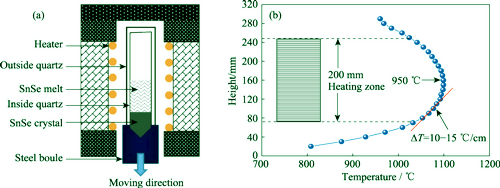
|
|
|
Co Incorporation on Structure, Conductivity and Magnetism of GaFeO3
XIA Zhaoyang, WANG Hui, FANG Jinghong, ZHANG Yang, WANG Chaoyue, HE Huan, NI Jinqi, SHI Yun, LI Qin, YU Jianding
2021 Vol. 36 (3): 319–324
 Abstract
Abstract(
456 )
 HTML
HTML(
12)
 PDF
PDF(1464KB)(
901
)
GaFeO3 is one of the most promising ferromagnetic materials due to its magnetoelectric coupling effect. GaFe1-xCoxO3 (x=0, 0.02, 0.05, 0.07, 0.10) ceramics were prepared by the conventional solid-state method, and the effect of Co substitution on the microstructure, electrical leakage and magnetic properties was investigated. The XRD patterns and Rietveld refinement using the FullProf package showed that the secondary phase with a Fd3ˉm space group was present in addition to the main GFO phase with a Pc21n space group, and with an increase of Co doping, the proportion of the secondary phase and the lattice distortion increased. The leakage current density of the GFCO-x samples decreased by approximately 7 orders of magnitude for Co=2at%. The improved magnetization in GFCO ceramics was attributed to the secondary phase and enhanced lattice distortion. This work suggests that the magnetism was improved by doping Co and the leakage current would be decreased sharply without prominent fluctuation of TC in the meantime by the incorporation of trace amounts of Co.

|
|
|
Facilely Anchoring Cu nanoparticles on WO3 Nanocubes for Enhanced Photocatalysis through Efficient Interface Charge Transfer
XIONG Jinyan, LUO Qiang, ZHAO Kai, ZHANG Mengmeng, HAN Chao, CHENG Gang
2021 Vol. 36 (3): 325–331
 Abstract
Abstract(
501 )
 HTML
HTML(
28)
 PDF
PDF(4305KB)(
959
)
Non-noble metal decoration is a promising strategy for promoting semiconductor photocatalysis by effectively enhancing charge separation. Cube-like WO3-Cu hybrid was successfully synthesized by a facile ascorbic acid reduction method at room temperature. The composition and morphology characterization showed that the Cu particle was deposited on the surface of WO3 nanocube. The WO3-Cu-1.0 hybrid (when 1.0 mmol CuSO4?5H2O was involved into the reaction system) exhibited promoted photocatalytic capability towards Congo Red photodegradation under simulated sun light irradiation. The trapping experiments of active species during photocatalysis and ESR spectra of DMPO?OH signal of WO3-Cu-1.0 composite confirmed that the photogenerated holes (h +), ?OH, and ?O2 -were the predominant active species during Conge Red degradation. Based on the photo/electro-chemical measurements, it was proposed that efficient charge transfer was accomplished between the WO3 nanocube and Cu nanoparticles, which promoted electron-holes separation and subsequently photocatalysis reaction in the Congo Red solution. This work provides a facile preparation method for a binary photocatalyst system in which a semiconductor coupled with non-noble metal.
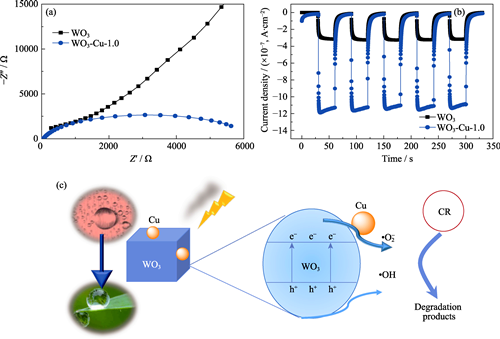
|
|
|
MOF/Poly(Ethylene Oxide) Composite Polymer Electrolyte for Solid-state Lithium Battery
LIANG Fengqing, WEN Zhaoyin
2021 Vol. 36 (3): 332–336
 Abstract
Abstract(
1260 )
 HTML
HTML(
72)
 PDF
PDF(2197KB)(
1492
)
Solid polymer electrolytes (SPEs) with high flexibility and processability enable the fabrication of leak-free solid-state batteries with varied geometries. However, SPEs usually suffer from low ionic conductivity and poor stability with lithium metal anodes. Here, we propose nano-sized metal-organic framework (MOF) material(UiO-66) as filler for poly(ethylene oxide) (PEO) polymer electrolyte. The coordination of UiO-66 with oxygen in PEO chain and the interaction between UiO-66 and lithium salt significantly improve the ionic conductivity (3.0×10 -5 S/cm at 25 ℃, 5.8×10 -4 S/cm at 60 ℃) and transference number of Li + (0.36), widen the electrochemical window to 4.9 V (vs Li +/Li), enhance the stability with lithium metal anode. As a result, the as-prepared Li symmetrical cells can continuously operate for 1000 h at 0.15 mA?cm -2, 60 ℃. The results show that UiO-66 filler is effective to improve the electrochemical performance of polymer electrolyte.
|
|